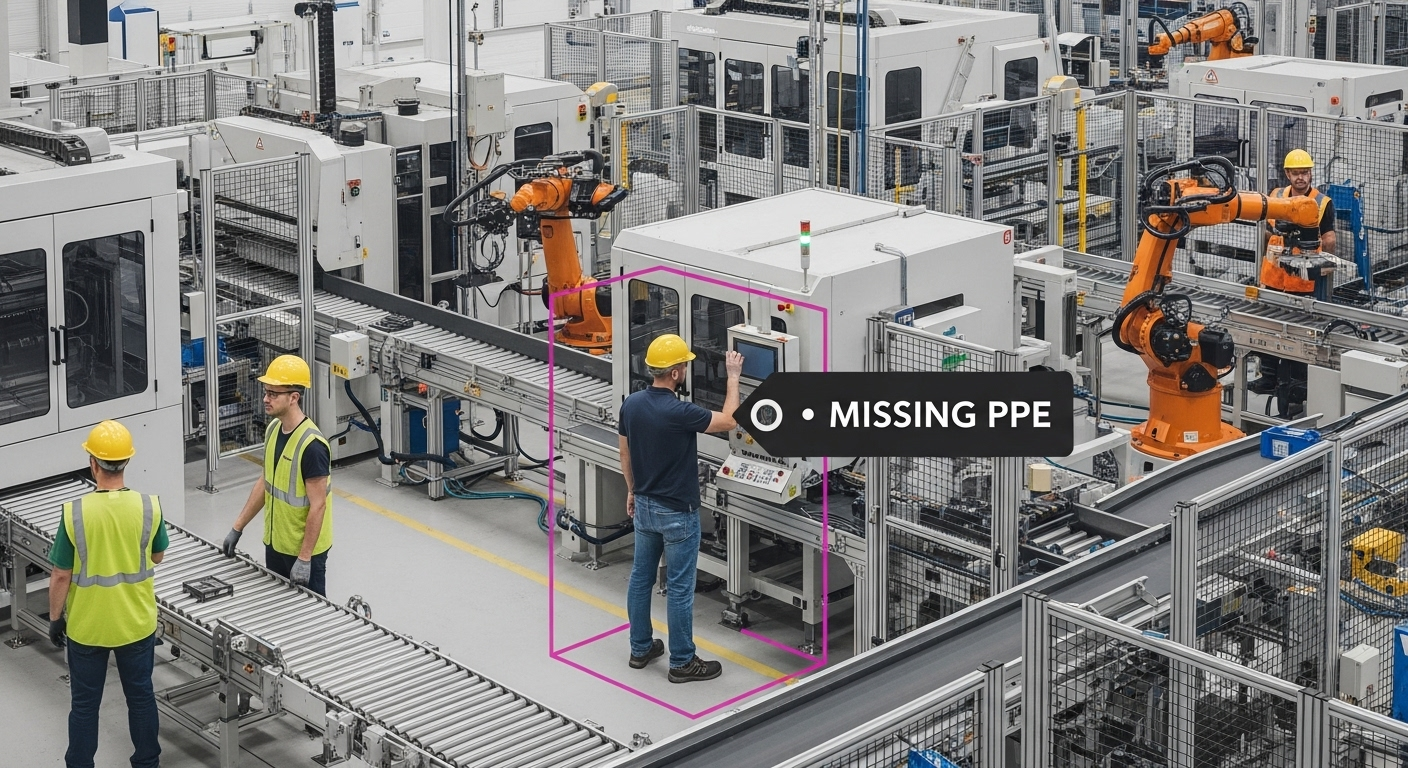Manufacturing floors present a distinct challenge for security leaders: every safety measure must protect workers and assets without disrupting the production processes that drive profitability. For professionals managing this balance, the task becomes more complex when legacy video systems operate in isolation from Manufacturing Execution Systems (MES), SCADA, and other OT platforms. This creates security blind spots where operational and security data cannot be correlated for thorough incident detection.
The convergence of Information Technology (IT) and Operational Technology (OT) systems has reshaped manufacturing cybersecurity. While traditional IT security focuses on data confidentiality and integrity, OT systems prioritize availability and real-time performance. When cybersecurity solutions designed for IT environments are applied to OT systems, they can interfere with production operations or create performance issues that affect manufacturing efficiency.
This guide addresses a key obstacle facing manufacturing security teams: how to implement safety protocol monitoring that strengthens both cybersecurity posture and operational efficiency without compromising production continuity.
Understanding the manufacturing compliance landscape
Manufacturing environments face compliance and safety considerations that differ from traditional IT environments. The stakes extend far beyond financial penalties, as a single compromise can halt operations, degrade performance, or cause data loss. IIoT cyber risks can also endanger worker safety, potentially leading to injuries, lawsuits, and reputational damage.
Key terms to know
Understanding these essential terms helps navigate the complex landscape of manufacturing safety compliance:
IT/OT Convergence: The integration of Information Technology (business systems) with Operational Technology (industrial control systems), creating new security challenges as previously isolated systems become interconnected.
SCADA (Supervisory Control and Data Acquisition): Industrial control systems that monitor and control plant operations, often targeted by cyberattacks due to their central role in production.
PLCs (Programmable Logic Controllers): Industrial computers that control manufacturing processes and machinery, requiring specialized security approaches that don't disrupt real-time operations.
Network Segmentation: The practice of dividing networks into smaller, isolated segments to limit attack surface and prevent lateral movement of threats—an essential practice where IT and OT systems must coexist.
IEC 62443: International standard for industrial automation and control systems security, providing a framework for securing OT environments.
NIST CSF (Cybersecurity Framework): Guidelines for managing cybersecurity risks, adapted for manufacturing environments to balance security with operational requirements.
Mean Time to Detect (MTTD): The average time to identify security incidents—an essential metric in manufacturing where every minute of delayed detection can mean significant downtime costs or safety risks.
RIDDOR: Reporting of Injuries, Diseases and Dangerous Occurrences Regulations—a key compliance requirement for manufacturing safety incidents.
Core obstacles in manufacturing safety compliance
Legacy system constraints
Manufacturing equipment often has decades-long operational lifecycles. Production systems installed years ago remain core to operations but may run on unsupported operating systems or software that cannot be easily updated. Traditional cybersecurity assumes regular patching and updates, but in manufacturing environments, system updates can require production downtime, extensive testing, and coordination with equipment vendors.
The IT/OT security divide
Daily coordination between IT and OT teams can create friction, as IT focuses on confidentiality while OT prioritizes availability and safety. This divide requires negotiation and compromise in security implementations, especially when conducting risk assessments in live production environments without triggering stoppages or safety system alarms.
Regulatory compliance complexity
The Occupational Safety and Health Administration (OSHA) oversees several general and industry-specific safety and health standards. Submission requirements for the OSHA 300 Log Form and 301 Log Form were expanded in 2024 for highly hazardous industries (Source: Occupational Safety and Health Administration). Key requirements include:
Hazard communication programs for chemical safety
Written emergency and fire prevention plans
Clear and unobstructed exit paths
Fall protection systems
Adequate medical and first-aid resources
Protection from amputation for hazardous machinery
Lockout/Tagout procedures for machines with unexpected startup risks
Electrical system designs protecting against hazards
Hearing conservation programs for excessive noise exposure
Confined space hazard assessments
Forklift operator training with post-training evaluations
Essential components of effective safety protocol monitoring
Automated monitoring capabilities
Advanced monitoring systems deliver prompt assessment of safety compliance, quality control, and operational efficiency through automated analysis of video streams, sensor data, and operational metrics. These systems replace manual floor walks and capture process variations through automated round-the-clock observation.
Data mapping: Identifying where sensitive data resides and who has access
Automated alerts: Notifying stakeholders of compliance issues quickly
Risk scoring: Offering measurable scales to evaluate and prioritize vulnerabilities
Video analytics for compliance enforcement
Video AI analytics enables prompt detection of safety violations, process deviations, and compliance issues across manufacturing facilities. Computer vision systems monitor adherence to safety protocols by tracking video feeds to verify workers are wearing proper safety gear, with any violations triggering prompt alerts.
Checking PPE (personal protective equipment) compliance
Monitoring workplace safety behaviors
Preventing unauthorized access to restricted areas
Implementing automated compliance monitoring
Overcoming integration challenges
To integrate security systems with OT infrastructure, organizations can use API-based connectivity that facilitates communication between platforms while maintaining network segmentation. Cloud-native architectures with on-premises bridge hardware allow for security monitoring without touching sensitive OT networks directly, maintaining air-gap protection while delivering advanced analytics.
Measuring safety KPIs effectively
Safety KPIs are quantifiable measures used to evaluate an organization's performance in maintaining a safe and healthy workplace. These indicators split into two categories:
Leading KPIs (proactive indicators):
Safety training completion rates
Frequency of safety meetings and equipment inspections
Lagging KPIs (reactive indicators):
Incidents reported under RIDDOR
Total number of accidents and incidents
Emergency response time
Total costs of incidents
Good health and safety KPIs follow the S.M.A.R.T. Goal model: Specific, Measurable, Achievable, Relevant, and Timely.
Implementation best practices
Phased deployment approach
Successfully implementing video AI while managing change resistance requires a systematic, phased plan:
Phase 1: Pilot project selection (30-90 days)
Start with narrow, high-impact use cases
Focus on areas where automation relieves known bottlenecks
Build confidence through quick wins
Phase 2: Expansion and optimization (3-6 months)
Expand successful pilots to additional production areas
Incorporate lessons learned from initial deployment
Refine processes based on user feedback
Phase 3: Full-scale deployment
Implement across all target areas
Complete integration with existing systems
Establish automated operations
Change management strategies
Address resistance by positioning video AI as an empowerment tool that makes teams more effective. Offer rollback options during initial phases and maintain human oversight to build trust. Clear communication protocols should explain AI-driven recommendations in terms that resonate with different stakeholder groups.
ROI measurement and justification
ROI from AI-based vision inspection demonstrates substantial returns. Some companies pay for their vision inspection system in under one year on labor cost savings alone (Source: Food Industry Executive). Benefits include:
Faster incident detection capabilities
Reduction in safety incidents
Prevention of costly downtime events
Balancing security with production continuity
Manufacturing security teams must evaluate every security measure against its potential production impact, creating a constant tension between strong security and operational efficiency. The solution lies in deploying security measures that enhance rather than hinder production, demonstrating that proper safety protocol monitoring can increase efficiency.
Building a resilient safety compliance program
As manufacturing environments continue to evolve, safety protocol monitoring must adapt to new challenges. The integration of IT and OT systems will deepen, creating both opportunities and vulnerabilities. Organizations that invest in flexible, scalable monitoring solutions position themselves to meet future compliance requirements while maintaining high performance.
Selecting camera-agnostic solutions that protect existing investments.
Implementing cloud-native architectures for scalability.
Using open API connectivity for future integrations.
Building in machine learning capabilities for ongoing improvement.
Maintaining human oversight while leveraging automation.
Streamline your manufacturing safety protocols
Ensuring manufacturing safety no longer means sacrificing productivity for security. Video AI solutions bridge the gap between IT and OT environments, delivering effective monitoring that enhances both safety and operational efficiency.
For professionals managing legacy system integration, budget justification, and the daily challenge of conducting risk assessments without disrupting production, new tools are available. API-based connectivity, cloud-native architectures, and intuitive interfaces help overcome the traditional barriers to effective safety protocol monitoring.
See how unified video AI delivers operational visibility, enhances safety, and keeps production running smoothly. Request a Spot AI demo to experience compliance monitoring in action—without interrupting your operations.
Frequently asked questions
What are the best practices for compliance monitoring in manufacturing?
Best practices include deploying a unified video AI platform to gain live visibility into operations and using automated alerts to address safety issues swiftly. It is also important to maintain thorough, time-stamped video evidence for audit trails, track S.M.A.R.T. KPIs, and adopt a phased deployment approach to demonstrate value before a full-scale rollout.
How can technology improve safety protocol enforcement?
Technology enhances safety protocol enforcement through AI-powered video analytics that can detect PPE violations, unsafe behaviors like running, and vehicles or people in restricted areas. Automated alert systems notify supervisors promptly of compliance issues, enabling quick intervention.
What are the key components of a safety management system?
An effective safety management system is built on a unified video AI platform that offers automated monitoring, risk scoring, and compliance verification. Key components include integration with existing camera systems, open APIs for connecting with other business tools (like ERPs), and reliable KPI tracking for both leading and lagging indicators to help balance security and production continuity.
How do automated solutions enhance compliance monitoring?
Automated compliance monitoring solutions reduce manual tracking, deliver round-the-clock observation across production areas, generate prompt alerts for intervention, and create thorough audit trails for regulatory inspections. These systems integrate with existing infrastructure through APIs, enabling automatic data collection and correlation while reducing the administrative burden on security teams.
What are the regulatory requirements for manufacturing safety compliance?
Manufacturing facilities must comply with a variety of OSHA requirements: hazard communication programs, written emergency plans, fall protection systems, machine safeguards, electrical safety measures, hearing conservation programs, confined space assessments, and forklift operator training. Additional requirements include maintaining OSHA 300 and 301 Log Forms, implementing PPE programs, and following industry-specific standards such as IEC 62443 for OT security and NIST CSF for cybersecurity frameworks.
About the author
Joshua Foster is an IT Systems Engineer at Spot AI, where he focuses on designing and securing scalable enterprise networks, managing cloud-integrated infrastructure, and automating system workflows to enhance operational efficiency. He is passionate about cross-functional collaboration and takes pride in delivering robust technical solutions that empower both the Spot AI team and its customers.

























.png)
.png)
.png)